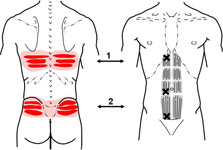|
A young man, 30, made an appointment as a last chance in finding relief from his back pain before surgery. As a teen he hurt his back in a fall. Physical therapy taught him some coping skills at best. As a steel worker in his 20’s, his back continued to hurt him. He later took an office job. His pain got worse. Surgery was his recommended course of action. Due to the location of his pain, straight line across his low back and straight line across his lower thoracics, mid back, I went directly to two specific trigger point locations on his abdominals. He worked out a lot and put a significant amount of time working on his abs. He did have a 6-pack. This was another indicator that I might find the culprit in hisabdominal muscles. “It’s my back that hurts. Why are you working on my stomach”, he questioned with disbelief. I replied, “If I work exactly where you hurt, 75% of the time I am working in the wrong place. It may feel good or right for me to work on the location of pain but I am more than likely NOT working on the cause of the pain. Plus all of the sitting you do followed by all the ab work you do in the gym, I think these muscles are shortened and may have trigger pointsthat can refer to the back.” It took less than 2 minutes to find the first trigger point in his rectus abdominus muscle that referred pain to his mid back. Working that trigger point referred pain straight through to his back and felt like “a rod going all the way through, just like it does when it hurts real bad”. The pain left. Working on his lower abdominals elicited the same response for his low back, again “like a rod going straight through just like it does when it hurts”. Again, his pain was alleviated. I also performed a pin and stretch on his deeper psoas muscle, a primary hip flexor, which mimicked even more familiar pain. Again, “that worked, I don’t hurt”. I taught him some stretches to do in order to maintain his pain free status. I also showed him how to find these trigger points on his abs so that he could treat himself when he hurts. He walked out without any pain. NO SURGERY NO REPEAT VISITS.
1 Comment
12/15/2013 01:53:33 am
How do you position and move the leg to perform a pin and stretch on the psoas muscle? Do you do a passive or active stretch?
Reply
Your comment will be posted after it is approved.
Leave a Reply. |
CategoriesAll Carpal Tunnel Chronic Cough Golf Low Back Pain Mid Back Pain Olympic Athlete Post Surgery Shoulder Thoughts Archives
September 2019
Bobby LewisNeuromuscular Therapist |

 RSS Feed
RSS Feed

